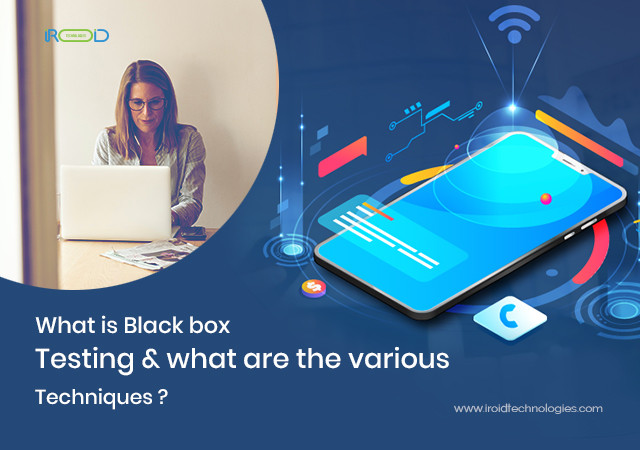What Is Black Box Testing And What Are The Various Techniques?

Black box testing includes testing a system with no former knowledge of its inner workings. A tester gives input and keeps the output created by the system below the test. This executes it possible to recognize how the system reacts to required and accidental user actions, its acknowledgment time, usability problems, and safety issues.
Black box testing is an important testing procedure because it utilizes a system end-to-end. Just similar to that like end-users “don’t care” how a system is coded or architected, and require to obtain a proper reply to their requests, a validator can affect user activity and recognize if the system performs on its obligations. Along the way black box test judges all associated subsystems and UI/UX, web server or application server, database, dependencies, integrated systems, etc.
Types Of Black Box Testing
Black box testing can be utilized in three main varieties. They are namely functional, non-functional, and regression testing.
Functional Testing
Black box testing can test particular functions or characteristics of the software under analysis. For example, indicating that it is likely to log in using true user credentials, and not reasonable to log in using wrong credentials.
Functional testing can concentrate on the most significant aspects of the software (smoke testing/sanity testing), on the alliance between key ingredients (integration testing), or on the system as a complex (system testing).
Non-Functional Testing
Black box testing can examine supplementary aspects of the software, beyond characteristics and functionality. A non-functional test does not review “if” the software can achieve a particular action but “how” it works that action.
Black box tests can reveal if the software is:
- Practical and effortless to assume for its users
- Performant under assumed or top loads
- Cooperative with relevant devices, screen sizes, browsers, or operating systems
- Presented to safety vulnerabilities or public protection threats
Regression Testing
Black box testing can be practiced to verify if a new variant of the software exhibits a regression, or degeneration in capacities, from one account to the next. Regression testing can be planted to functional features of the software (for example, a particular characteristic no longer works as required in the new version), or non-functional aspects (for example, an execution that worked well is really slow in the latest version).
Black Box Testing Techniques
Equivalence Partitioning
Testers can share possible data into groups or “partitions”, and test only one precedent input from each collection. For example, if a policy requires a user’s birth date and gives the same answer for all users beneath the age of 18, and a mixed response for users above 18, it is satisfactory for testers to review one birth date in the “under 18” group and one date in the “above 18” assortment.
Boundary Value Analysis
Testers can recognize that a system has a specific acknowledgment around a particular boundary value. For example, a particular field may accept only conditions between 0 and 99. Testers can concentrate on the boundary values like -1, 0, 99, and 100. With this, they can see if the system is taking and declining inputs accurately.
State Transition Testing
In some methods, significant acknowledgments are created when the system changes from one state to another. A common pattern is a login mechanism that enables users to confirm, but after a particular number of login tries, transition to a separate state, securing the account.
If testers identify a state transition in a device, they can design test cases that consider the system. For instance, for a system that ensures the account after five dismissed login attempts, a test case can prevent what appears at the sixth login effort.
How to do Black Box testing?
When you get the necessary knowledge of black-box testing then the next issue which comes to mind is: How to achieve Black box testing? Below you can review the steps to complete this testing:
- The first level of black-box testing is to follow the required specs of the application under examination. An authentic and correct SRS document should be available.
- The next step is to decide the set of valid data and analysis scenarios to examine the software. The purpose is to save time and get great test coverage.
- Make the test cases reach a maximum expanse of inputs.
- The test cases are included in the system to generate output, which is impressed with the expected consequence to signal pass or fail.
- The broken steps are recorded and sent to the development team to correct them.
- Retest the system using different testing techniques to support its recurring character or to transfer it.
The black box testing can be simply used to review and verify the entire software development life cycle. It can be practiced at multiple stages such as unit, integration, recognition, system, and regression to estimate the product.
What are the benefits of Black Box testing?
- The tester doesn’t need any professional knowledge to test the system. It is necessary to understand the user’s viewpoint.
- Testing is carried after development, and both projects are free of each other.
- It works for more comprehensive coverage which is normally missed out by testers as they leave to see the larger picture of the software.
- Test cases can be created before development and immediately after designation.
- Black box testing methodology resembles agile.
Conclusion
We seldom think about someone critiquing our work, yet a few lucky people are paid to do so. This group of people is known as Testers, and their job is to test software programs. Testing, as enjoyable as it may sound, is not without its drawbacks. Black box testing is performed when the functionality of software development must be tested without the usage of internal code.
Finding flaws in functioning, usability, and other features is an advantage of black box testing. This type of testing offers an overview of the software evaluation and its results. It enhances software functionality and reduces time to market. Conduct this type of testing in collaboration with iROID Technologies to reduce the possibility of software faults at the user's end.

